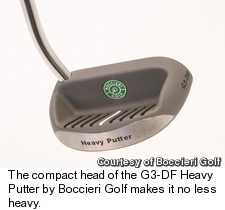 EQUIPMENT REVIEW
EQUIPMENT REVIEW
G3-DF Heavy Putter by Boccieri Golf: Big muscles, big putts
By Kiel Christianson,
Senior Writer
Got a "wristy" putting stroke? Try the Heavy Putter by Boccieri Golf Deep Face Series G3-DF.
Perhaps the single biggest flaw in average golfers' putting strokes is the involvement of the hands and wrists. "Wristy" strokes were all the rage for most of the history of golf, when a bit of a "pop" was required to get the ball on top of the turf (or oiled sand) and rolling smoothly. Modern players, however, do their best to take the hands and wrists out of the putting stroke, using instead the shoulders and arms synched together in a pendulum-like stroke.
One of the most innovative putter designs specifically engineered to force golfers to use their big muscles is the Heavy Putter by Boccieri Golf. As the name says, the putter is heavy, 850-900 grams - weighing almost twice as much as a conventional putter. More importantly, though, is the distribution of the weighting. All Heavy Putters include grip-end weighting, to further induce a big-muscle stroke.
The Deep Face (DF) series was introduced last year by Boccieri, and all models in the line feature putter faces .25" higher than other Heavy Putters, and 75 percent higher than competitors' putters. The idea is to align the center of gravity of the clubhead with the equator of the golf ball, making for sweeter contact and better feel and roll.
How Boccieri's G3-DF plays
We tested the G3-DF "Rake" model (MSRP $169) from the Deep Face line. The G3-DF is, according to the company, "[a] traditional mallet with novel alignment lines sloping toward the putter face for top visual acuity. This putter also incorporates moving mass around the perimeter to maximize its MOI."
|
Apart from the considerable weight, the first things you notice when inspecting the G3 are the Winn grip - which is an eye-catching green, gray and black sort of camouflage pattern—and the putter head, which is an unfinished matte gray. The head is quite compact, with almost zebra-like black alignment lines and one white center line in a sort of scooped-out back.
In short, it's a mallet that doesn't look exactly like a mallet, due to the smallish head and visual effects.
We put the G3-DF through its paces (once the snow melted here in the northland). On the practice green, we noticed immediately how the putter engages the shoulder and upper-arm muscles. The head-to-grip weighting sort of pulls your body through the putt.
Distance control was much better, it seemed, than a previous Heavy Putter model we reviewed, the B3-M.
The key on short putts is alignment. Because the putter is so heavy, it is quite difficult not to really power through the short ones, and if alignment is off, they'll run a long way past the cup. What worked best on putts within two or three feet was to take the putter back just a few inches, and just kind of let it fall back toward the ball.
What absolutely didn't work was to take the putter back too far, and then try to slow the putterhead as it returned to the ball. Of course, this is bad with any putter. But with the aptly-named Heavy Putter, it is the kiss of death.
Not only will you end up with a lot of missed putts, but you'll also end up with very tired forearms and hands. (Seriously, it hurt to steer my car after one long practice session.)
It is precisely this discomfort that the Heavy Putter is designed to induce in wristy putters. The result will be either a more pendulum-like stroke, or forearms like Popeye.
For more information, visit www.heavyputter.com.
April 23, 2008
Any opinions expressed above are those of the writer and do not necessarily represent the views of the management.